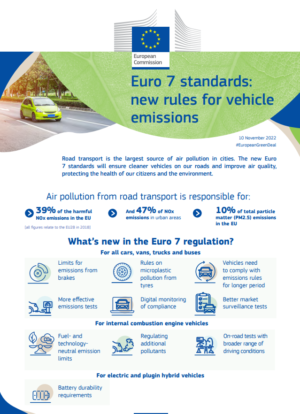Proposed Euro 7 standards include tyre and brake particle emissions
 (Photo: Lukasz Kobus; European Union)
(Photo: Lukasz Kobus; European Union)
The European Commission published details of the new Euro 7 standards on 10 November 2022. According to the commission, Euro 7 will “ensure cleaner vehicles on our roads and improved air quality, protecting the health of our citizens and the environment.” The transport industry has become familiar with the increasingly demanding Euro series of standards over the years. Up till now, they have focused on vehicle exhaust emissions, something that tyres can only indirectly affect through reduced rolling resistance and its impact on fuel consumption and therefore emissions. This time round however, Euro 7 brings with it standards relating to particle emissions from tyres and brakes.
The shift to include tyre and brake emissions is partly a result of increased take-up of electric vehicles that don’t create exhaust emissions. In the commission’s words Euro 7 is designed to “ensure that cars, vans, lorries and buses are much cleaner, in real driving conditions that better reflect the situation in cities where air pollution problems are largest, and for a much longer period than under current rules” and therefore “the proposal tackles emissions from tailpipes as well as from brakes and tyres.”
As far as impact is concerned, by 2035, Euro 7 is expected to lower total NOx emissions from cars and vans by 35 per cent compared to Euro 6, and by 56 per cent compared to Euro VI from buses and lorries. At the same time, particles from the tailpipe will be lowered by 13 per cent from cars and vans, and 39 per cent from buses and lorries, while particles from the brakes of a car will be lowered by 27 per cent. Projections relating to the impact on tyre particulate are noticeable by their absence.
Euro 7, the main changes
Nevertheless, the focus will remain on exhaust emissions for some time. As the commission points out, while by 2035 all cars and vans sold in the EU will have zero CO2-emissions, in 2050 than 20 per cent of cars and vans and more than half of the heavier vehicles in our streets are expected to continue to emit pollutants from the tailpipe.
The latest Euro 7 proposal replaces and simplifies previously separate emission rules for cars and vans (Euro 6) and lorries and buses (Euro VI). The Euro 7 standards rules bring emission limits for all motor vehicles, including cars, vans, buses and lorries under a single set of rules. The new rules are fuel- and technology-neutral, placing the same limits regardless of whether the vehicle uses petrol, diesel, electric drive-trains or alternative fuels.
They are designed to help to better control emissions of air pollutants from all new vehicles by: broadening the range of driving conditions that are covered by the on-road emissions tests. These will now better reflect the range of conditions that vehicles can experience across Europe, including temperatures of up to 45°C or short trips typical of daily commutes.
Limits will be tightened for lorries and buses while the lowest existing limits for cars and vans will now apply regardless of the fuel used by the vehicle. The new rules also set emission limits for previously unregulated pollutants, such as nitrous oxide emissions from heavy-duty vehicles.
Euro 7 rules will ensure that vehicles are not tampered with and emissions can be controlled by the authorities in an easy way by using sensors inside the vehicle to measure emissions throughout the lifetime of a vehicle.
And, of course, the Euro 7 standards rules will be the first worldwide emission standards to move beyond regulating exhaust pipe emissions and set additional limits for particulate emissions from brakes and rules on microplastic emissions from tyres. These rules will apply to all vehicles, including electric ones.
The European Commission (EC) announcement explains that Euro 7 comes in the context of road transport being the largest source of air pollution in cities. In 2018, more than 39 per cent of NOx and 10 per cent of primary PM2.5 and PM10 emissions in the EU came from road transport, according to EC data. These percentages are reportedly “much higher” in cities, where transport is regularly the main contributor to air pollution.
The rules on pollutant emissions are complementary to the rules on CO2 emissions. The agreed target for 100 per cent CO2 reduction by 2035 for cars and vans has been taken into account in this proposal. The Commission will review in the coming months the CO2 standards for lorries and buses.





Comments